Intel Xeon E5-2697 v2 and Xeon E5-2687W v2 Review: 12 and 8 Cores
by Ian Cutress on March 17, 2014 11:59 AM EST- Posted in
- CPUs
- Intel
- Xeon
- Enterprise
Scientific and Synthetic Benchmarks
2D to 3D Rendering –Agisoft PhotoScan v1.0: link
Agisoft Photoscan creates 3D models from 2D images, a process which is very computationally expensive. The algorithm is split into four distinct phases, and different phases of the model reconstruction require either fast memory, fast IPC, more cores, or even OpenCL compute devices to hand. Agisoft supplied us with a special version of the software to script the process, where we take 50 images of a stately home and convert it into a medium quality model. This benchmark typically takes around 15-20 minutes on a high end PC on the CPU alone, with GPUs reducing the time.

For PhotoScan, the extra cores and MHz from the Xeons means most in the first stage of the computation. The second stage shows an increas in CPU Mapping Speed, however this is the stage where the GPU can accelerate when in use. Stage 3 benefits more from the MHz of the 8-core model, and the final stage is about even.
Console Emulation –Dolphin Benchmark: link
At the start of 2014 I was emailed with a link to a new emulation benchmark based on the Dolphin Emulator. The issue with emulators tends to be two-fold: game licensing and raw CPU power required for the emulation. As a result, many emulators are often bound by single thread CPU performance, and general reports tended to suggest that Haswell provided a significant boost to emulator performance. This benchmark runs a Wii program that raytraces a complex 3D scene inside the Dolphin Wii emulator. Performance on this benchmark is a good proxy of the speed of Dolphin CPU emulation, which is an intensive single core task using most aspects of a CPU. Results are given in minutes, where the Wii itself scores 17.53; meaning that anything above this is faster than an actual Wii for processing Wii code, albeit emulated.
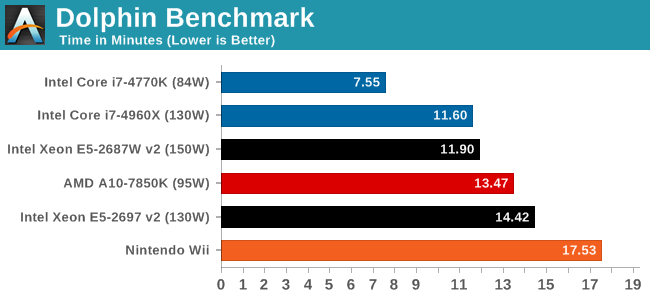
Emulation is a pure single threaded affair, and the IPC improvements of Haswell stand out a lot against the Ivy Bridge-E based Xeons.
Point Calculations – 3D Movement Algorithm Test: link
3DPM is a self-penned benchmark, taking basic 3D movement algorithms used in Brownian Motion simulations and testing them for speed. High floating point performance, MHz and IPC wins in the single thread version, whereas the multithread version has to handle the threads and loves more cores.
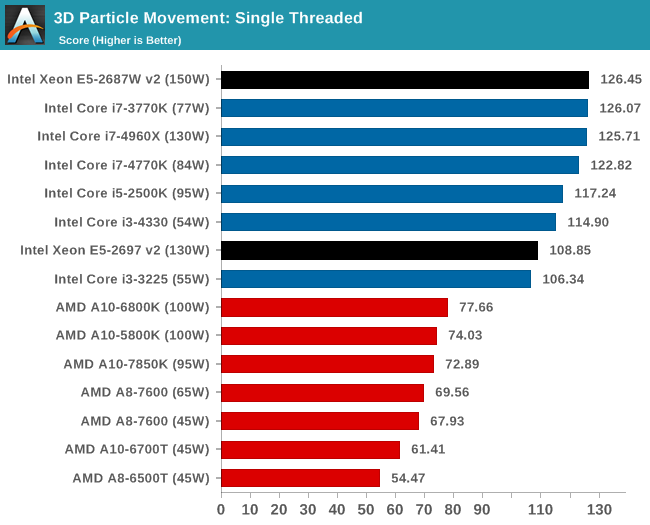
The low core frequency of the 12-core Xeon puts it behind in our FP single threaded benchmark.
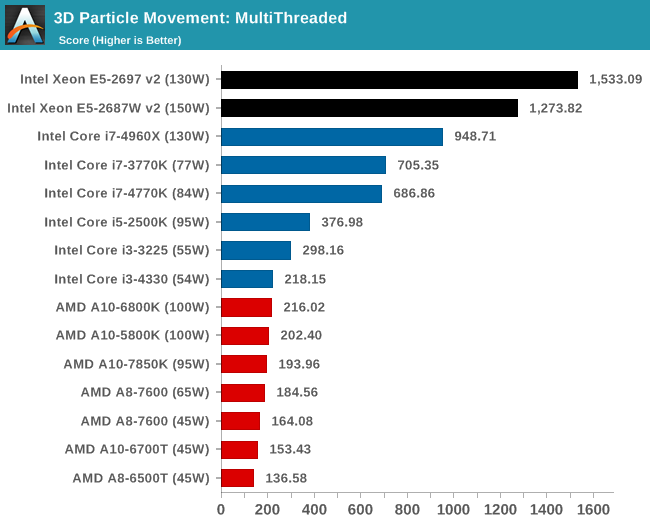
In out multithreaded scenario, we see the situation similar to PovRay, where cores and frequency take top spots.
Encryption –TrueCrypt v0.7.1a: link
TrueCrypt is an off the shelf open source encryption tool for files and folders. For our test we run the benchmark mode using a 1GB buffer and take the mean result from AES encryption.
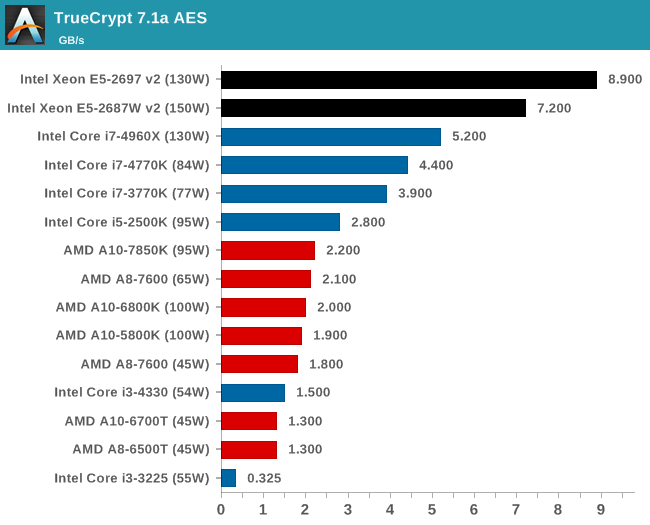
Synthetic – 7-Zip 9.2: link
As an open source compression tool, 7-Zip is a popular tool for making sets of files easier to handle and transfer. The software offers up its own benchmark, to which we report the result.
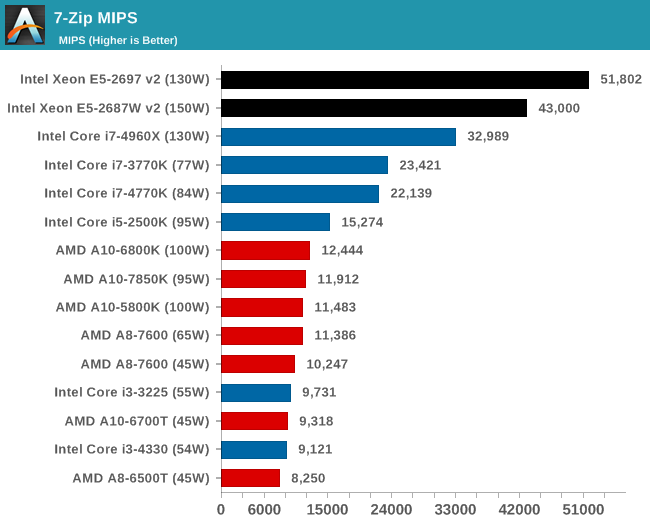










71 Comments
View All Comments
SirKnobsworth - Monday, March 17, 2014 - link
The LGA 2011 i7 chips don't have integrated graphics.Voldenuit - Monday, March 17, 2014 - link
Yeah, the Xeon E3s are great processors for enthusiasts/consumers.I was tossing up between an E3-1230 v3 (2MB more cache) or an i5 4670K (IGP, unlocked multiplier) in my latest build, and ended up with the 4670K because it had a $30 instant rebate, and I wanted quicksync (I know Ganesh says it has inferior transcode quality to x264, but I just need something quick and dirty for my phone, and honestly, I'm seeing more artefacts in the x264 samples he posted than in the QS samples). But it wasn't an easy decision.
Minor nitpick: you can get Xeon E3s with Intel HD graphics. Those are model numbers E3-12x5
http://ark.intel.com/products/family/78581/Intel-X...
mazzy - Monday, March 17, 2014 - link
Even more if you think about the facts that E3 xeons are i7 at i5 price... with ECC and VT tech... ok no OC...MrSpadge - Tuesday, March 18, 2014 - link
I'd take a CPU with IGP any day, unless it costs significantly more. Reason: increased resale value, even if I don't use the IGP myself.CrazyElf - Tuesday, March 18, 2014 - link
"I'd take a CPU with IGP any day, unless it costs significantly more. Reason: increased resale value, even if I don't use the IGP myself."I would not.
Reason is even when you use discrete, it uses additional power. IIRC for Sandy Bridge, a 3.6 GHz Sandy without the IGP switched on uses as much as a 3.4 GHz with the IGP on. Seeing that the graphics have become a bigger emphasis with Haswell, I expect that the IGP will be using a bigger percentage of the total power consumption with time.
austinsguitar - Monday, March 17, 2014 - link
okay...please tell me im not the only one who thinks this article is hilarious! look...if you are going to review two very expensive cpu's, don't test these against normal cpu's. It is shear idiocy to compare these to "desktop cpu's" because they are not....at all. Why can't anandtech do reviews on other affordable xeons and compare them all together. Also funny how they included AMD. That's cutejemima puddle-duck - Monday, March 17, 2014 - link
It's spelt 'sheer'. That aside, your ideas are intriguing to me, and I wish to subscribe to your newsletter.PEJUman - Monday, March 17, 2014 - link
you're the only one who think this article is hilarious.I thought/wished about this dataset previously. What if we simply go to XEONs and trade off clock for cores. i.e. the next logical progression from i7-4960X price bracket. obviously with no control over turbo bins & OC capability, the single thread is hosed. But wondered how many cores near-pro programs can really utilize.
I am just glad we get to see some comparisons. getting more XEON dataset would be interesting but I think it's beyond most of Anandtech reader usage partern.
austinsguitar - Monday, March 17, 2014 - link
You do indeed have a point about consumer cpu's and how they can overclock and are nifty to have for changing multiple options. but...the xeon market for average consumers needs to either be booming or a well kept secret. the 1230v3 is a fantastic cpu and can (for the most part) equal a 4770 for 240 dollars. I know it can not be overclocked, but people (about 70% of the market) do not give a care.But anandtech viewers are overly intelligent arnt we?
MrSpadge - Tuesday, March 18, 2014 - link
Had they not included these regular CPUs people would (rightfully) complain "what do these numbers mean without familiar comparison points?" Comparing 2 products to work out the real-world differences for some specific application is completely different from claiming they'd be equal.